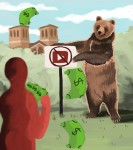It’s straight out of a Hollywood movie: the rolling, grassy hills by Janss Steps are dotted with students soaking up some California sunshine as they pore over class materials. However, for one woman, the fantasy is shattered as a random man approaches her exclaiming,“Your booty is getting burnt, would you like some tanning lotion?”
What follows is an awkwardly tense exchange of sexually explicit “pickup lines,” all of which is filmed from afar by a 25-year-old man with professional video recording equipment.
UCLA has a YouTube problem, and it’s not getting any better. Just in the last month, four videos were posted, each of which prominently featured the campus. Among these was one of the comeback videos of the infamous Logan Paul, a YouTuber most recently in the news for filming a dead body in Japan’s “suicide forest.“ At their very best, these videos are disruptive and obnoxious to students attempting to carry out their daily lives. At their worst, they constitute sickening and exploitative harassment that allow YouTubers to gain followings and monetize their acts through advertisements and increased merchandise sales.
Luckily, UCLA has infrastructure to prevent the posting and monetization of these videos. The challenge, however, is the university’s case-by-case approach to dealing with these videos: an outdated and unrealistic strategy for filtering through the numerous videos on YouTube. The university must update the way it enforces existing policy by providing a clear and advertised process for students to file complaints about problematic YouTube filming they see.
What’s most egregious about a lot of these prank videos is that recorders may use student images and reactions without their explicit consent.
“I wouldn’t care if I was just walking in the background,” said Sharon Han, a fourth-year biology student. “If it was more focused on my reaction, that’s something that I would want to give consent for.”
UCLA is a public campus, so YouTubers often incorrectly assume the same filming restrictions that apply in public spaces apply here. VitalyzedTV, a YouTuber known for his prank videos, had a similar misconception in his recent vlog on UCLA’s campus – a video that includes everything from him watching porn in Powell Library to him running a blender in a library, all with the intention of pranking and disrupting students.
“This is a public school, so technically I can film, maybe I can’t upload but that’s never stopped me before,” the YouTuber said in a video where he reflected on his pranking escapade.
However, UCLA has very strict restrictions on all filming projects on campus. Chansoth Hill, the Director of UCLA’s Events Office, said UCLA Policy 863 spells out who can film on campus and what the approval process is for doing so.
Any film project on campus must get approval from the Events Office to obtain a permit to film at UCLA. The parties seeking to record on campus must pay certain fees and follow a list of restrictions laid out by the university, including getting preapproval of the film concept, script or any locations being filmed. Hill said the reason for this policy is to protect students as well as help the university control what its image is being associated with.
“Just from my experience, because we have students and athletes, there is a privacy issue. If you come to school, you want to learn; you don’t want to be filmed,” Hill said. “(The policy is) here to protect that concept.”
While this set of rules was drafted in 2004, before YouTube was created, Hill said YouTubers who want to film are treated like any other commercial film project. Hill added when her office becomes aware of any illegal filming, it assesses the video and brings it to the attention of UCLA’s legal department.
“I can assure you that if someone brought a complaint to my office and knew who the YouTuber was, I would do everything in my power to see that (the video) got taken down,” Hill said.
But many students assume that a public campus means they don’t have rights when it comes to them being filmed on campus and included in videos monetized online. This idea discourages them from bringing complaints to administration.
“I don’t know of any way to report a violation of on-campus filming to the administration,” said Amy Nguyen, a first-year pre-psychobiology student. “But, if it is against what the school says, there should be a process for reporting it that students know about.”
UCLA has to change its enforcement tactics if it is to continually ensure the spirit of its filming policy is protected. It is impossible for the university to comb the internet for every video posted with the campus featured in it. As a result, the administration must clearly publicize students’ rights when it comes to being filmed.
Additionally, it must provide a clear process for reporting filming violations to the university. A reporting system would allow the university to identify violators and use its legal department to prevent the continual posting and monetization of these videos, without having to hire additional staff to seek out the videos. YouTube has a fairly simple process for issuing legal claims against videos, and UCLA could easily cut off ad revenue for vloggers who make a living off being nuisances on campus.
The university needs to adapt to the changing media landscape. Bruins signed up to be part of a vibrant educational environment, not to be cash cows for raucous, older men.

lmfao, those pranks are funny. you sound like a lil b**** complaining